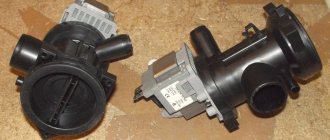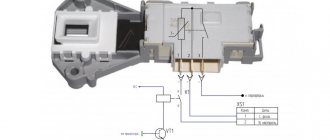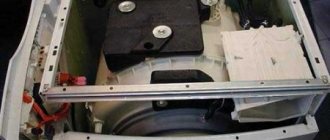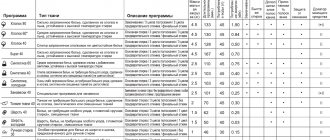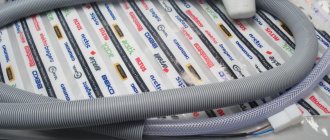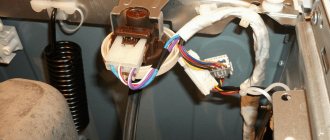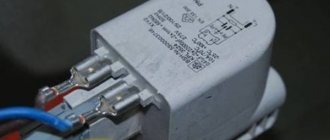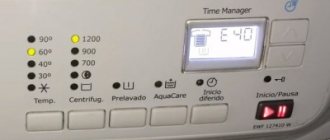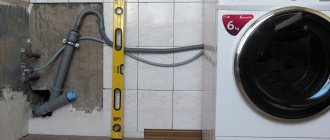The temperature sensor of the washing machine is the first link in the system responsible for achieving and fixing the heating level. Data from the electronic sensor is analyzed by a microcontroller, which turns the heating element on or off. If the thermostat is mechanical, then the detector is of the same type and acts directly on the relay. All problems with maintaining temperature can be associated with breakdowns of the temperature sensor. There are similar symptoms for malfunctions of the relay, thermostat, and electronics, so it is important to carry out the diagnosis correctly. Let's look at how to determine that the temperature sensor is broken, how to check it and replace it.
What is a temperature sensor, types
A thermal sensor is an element that determines the temperature in the measured environment and transmits the indicators to the control system, relay. In our case, it is also advisable to call the product in question a sensor-relay, a thermal relay, since the sensor of such a release is usually a difficult-to-separate part of it, it is a unit with a high degree of integrity, a module.
Mechanical types of heat detectors act on the relay directly, moving the contacts, closing or opening them. For any type of product, monitoring is carried out in real time, the element is always in working condition.
Thermal sensors of washing machines can be of 2 types:
- electronic (thermistors, thermistors, thermocouples). With two wires, terminals through which a weak voltage is supplied to the sensitive element. The thermistor changes resistance depending on heating/cooling. The data is received by the control electronics. The sensor has a microcontroller, which receives commands from the latter to close or open contacts depending on whether the temperature reaches or does not reach the user-set values;
- mechanical. This is a tube or segment with a temperature-sensitive substance, a material that, when heated/cooled, expands or contracts, respectively, pressing on the bellows with a rod in the thermostat or weakening the pressure by opening/closing the contacts.
Below we will consider the types of thermal sensors of washing machines more specifically. Similar elements are installed in all devices where they are required to be turned on/off. depending on the temperature achieved: for refrigerators, irons, convectors, and other heating equipment.
Bimetallic
Heat sensors with a bimetallic part belong to the mechanical variety of such meters. The sensitive segment is a plate made of two layers or strips of different metals. When heated/cooled, the segments do not expand/contract equally because they have different coefficients of response to temperature.
The plate connected to the contacts bends and moves them accordingly - closing or opening them. The force can be transmitted through a ceramic rod that performs the specified movement.
This type of sensor is largely an element inseparable from the relay. A thermostat with such a sensor is considered as a single unit; its part in the form of the described sensor is almost never changed separately. That is, it is difficult to separate the sensitive element from the relay and install a new one. This replacement segment is difficult to find on sale; you can only take it from used devices.
Another obstacle to replacing only the sensor part: usually thermostat models with such components by design do not provide for the possibility of dismantling it. The segment is soldered or inserted in such a way that when removed, the seat will be damaged. However, theoretically it is possible to replace it, but they don’t do it also because it creates a high probability of miscalibration. Usually they buy a whole relay.
A bimetallic detector breaks down extremely rarely, less often than all other options - due to its simplicity and solid design, there is nothing special about it that fails even from wear and tear over time. It is not afraid of an aggressive environment, voltage or temperature changes. In fact, the entire assembly is two strong, durable plates that move the same terminals. The only possible possibility is oxidation and sticking of the contacts inside. The advantage of such products: almost eternal performance, low cost. Cons: small measurement range, inaccuracy, slow response.
Gas-filled
The second type of mechanical temperature sensors in washing machines are gas-filled (capillary) sensors. This is a sealed tablet, a thickening, a flask on the same tube that goes into the thermostat. The listed elements are hollow, inside there is a substance that reacts to heat and cold, usually freon, maybe an arc-like gas.
The end that goes into the thermostat is equipped with a bellows - a part resembling a metal accordion, which provides a more stable (fixed) tension and compression than a spring.
The principle of operation is this: when the temperature changes, the state of the substance inside the tablet and tube changes, pressure arises, moving its end with the bellows, which in turn moves the rod, which affects the contacts, closing/opening them.
The level of inseparability of such a sensor from the relay and the impracticality of repair are similar to those described above. The gas-filled sensor is also very durable due to the simplicity of the design and its mechanical type. Typical failures: souring, sticking of contacts inside the relay, depressurization of the tube with the bulb.
NTC: thermistor, thermocouple
Thermistor (thermal resistor) and thermocouple are resistance sensors (NTC type - Negative Temperature Coefficient). Technically these are different elements. But we will use these 2 names or generalized terms - electronic sensor or with a microcontroller, since the aspect under consideration is similar. Thermistors are used in washing machines; they provide more accurate measurements.
Operating principle: a small voltage is applied to the sensitive element (thermistor, thermocouple). Depending on the temperature, the material of these elements changes resistance, which is analyzed by the microcontroller (relay) and, depending on the values of the heating settings set by the user, closes or opens the contacts of the heating element.
The electronic sensor consists of segments:
- the sensitive part is enclosed in a small housing, about 10 mm in length and several mm in width. This, strictly speaking, is the main functional part, the sensor tip, the thermistor itself, the thermocouple;
- a cable with two wires with a plastic plug that connects to the connector of the control unit, the electronic board of the washing machine. In this part there is also a microrelay that moves the contacts. More often, such a sensor does not have a cable between the chip and the thermistor - the terminals and relays in the plastic key are immediately connected to the sensitive part.
The two previous types of mechanical sensors are installed in washing machines with controls and thermostats of the same type. This is not to say that such products are not effective; their advantage is an increased service life, they are less likely to break down, since there are fewer electronic parts. Disadvantage: fewer “smart” and advanced features, small adjustment range. For mechanical control, characteristic selectors are in the form of knobs, and there are no touch screens.
Thermistor detectors are installed in washing machines with electronic controls. They break down more often, but are cheap, and make it possible to install a control system with more advanced options, with an expanded range of adjustments, and programmability. Such devices may have a selector knob (it is not completely mechanical, but connected to electronics), but a more typical touch screen, LCD display.
Advantages of a temperature sensor with a microcontroller, including maintainability:
- the most accurate of all possible options;
- If it fails, it is enough to change the part with the sensitive element, wiring and chip. If the model has a cable and it is intact, then you can cut off and solder only a new tip;
- ease of dismantling/installation: just unclip the wiring from the chip (block) and remove the element from the seat on the outer plate of the heating element. The overall thermostat housing, like a mechanical one, does not need to be removed from the control unit;
- cheap: you only need to buy a segment with a plug and a thermistor (thermocouple) - it has everything, including a relay. This small device costs much less than mechanical types of sensors.
Cons: electronic sensors break down more often and are more susceptible to failure due to power surges or aggressive environmental influences. This disadvantage is relative - to summarize, the service life of such sensors is shorter, but not too different from mechanical options, which is also affected by the lack of moving parts.
Diagnostic features, symptoms of temperature sensor failures
The diagnostic problem is that the same symptoms as in the case of a faulty temperature sensor can be observed when the heating element (heating element) breaks down. Since the latter breaks down more often, it is worth checking it first - at least doing an external inspection, ringing its circuit with a tester.
The described disadvantage is eliminated if the washing machine is electronically controlled with a self-diagnosis function. In this case, the system will issue a sound, light or graphic signal (code). The decryption of the alarm message is in the instructions.
The remaining symptoms are as follows (especially relevant for a mechanical type of control without self-diagnosis):
- t° jumps, does not correspond to the set values. For example, with any program, mode, setting, the value rises almost to a boil. The body parts heat up and steam is observed near the loading hatch. This mode is especially dangerous - with constant overheating, the heating element will quickly fail;
- The heater does not turn on, the washing machine does not heat the water at all. That is, here the sensor has completely failed and does not provide any indicators.
To diagnose, you need to gain access to the sensor; let’s look at where it is located and what the dismantling process is.
Repair of household appliances
Repair of household appliances at home
On the pages of my website you can carry out independent repairs of various household appliances. Many people ask me why I reveal the secrets of my craft, which have been accumulated for decades. I’ll answer this way: I’m tired of picking up trash after all sorts of unscrupulous craftsmen. The fact is that a person should know what he will have to do if a washing machine or refrigerator is repaired. The site was made more for informational purposes, and not with the goal of teaching the average user how to repair a vacuum cleaner or something like that, but honestly, if you succeed in something, I will be only happy. Masters who write angry reviews in my direction should cool down a little and think that only a tiny part of the people who read articles on this site will be able to do what the master does. Conscientious craftsmen must understand that a lot of handicrafts have appeared and because of them, normal craftsmen lose confidence, since the owner of household appliances does not even understand that the same work can be done in completely different ways. People often come to my workshop asking me to fill the refrigerator with freon, when you start to explain to them that this is not a matter of 5 minutes, people just laugh and leave, I tell this as an example of the irresponsibility of those craftsmen who simply love money, but you can actually fill it and in 5 minutes, but no one can say how long this refrigerator will work. Now imagine a person called a repairman, he threw freon into his refrigerator and left, and after a week this refrigerator stops freezing. It is clear in this case that the consumer does not think long and goes to the store to buy a new refrigerator, but no one explained to him that there may be a leak in the refrigerator or a clogged capillary, that first the cause must be eliminated, and only then the consequence. To the owners of any household appliances, I can say the following: almost everything can be repaired, it comes down to the price and how long your appliance will work after repair. This is what we will talk about next
Location of temperature sensors in the washing machine
The standard location for thermal mechanical detectors is near the heating element or drum, at the bottom of the housing, close to the motor, on a special plate with a hole-mounting area. The latter is a niche that goes into a tank of water so that it is possible to analyze the temperature of the liquid by almost touching it.
The electronic temperature sensor in the washing machine is located directly in the heating element, at its base, on the fixing plate. Outside, when the heater is mounted, its chip is visible, inside the tank - the thermistor itself in a small case.
How to check the temperature sensor in a washing machine?
Typically, simple washing modes require heating up to 30°C. In some cases, malfunctions lead to the fact that the sensor does not send a signal to stop the heating element, so the machine continues to heat the water to the maximum possible temperature. In such cases, repairs are needed because it can ruin the laundry or lead to high energy costs.
The malfunction may lie not only in the temperature sensor, but also in a special programmer responsible for automatic control. Features of the test depend on the specific variety.
Malfunctions of bimetallic sensors are usually associated with mechanical damage or wear, as a result of which the electrical circuit does not open. As a result, the water is brought to a critical boiling point. To check the status you need to do the following:
- partially disassemble the body of the washing machine;
- remove the wire terminals from the temperature sensor;
- use a multimeter on the contacts when selecting different modes.
The resistance should be the same, but during faults it will differ under different conditions.
A gas-filled thermostat is larger than a bimetal thermostat and includes a copper capillary tube. Usually the malfunction is associated with damage to this freon tube. If the gas evaporates, the temperature is determined incorrectly. The following procedures are carried out for verification:
- partially disassemble the body of the machine to get to the sensor;
- use a multimeter to measure the resistance between the terminals;
- listen to see if there is a characteristic click when the contacts open when the heating element stops heating.
Related article: How to check the pressure switch of a washing machine
Thermal sensors of a washing machine are usually located at the bottom of the tank. Care must be taken not to damage the copper tubing during repairs.
Modern models of washing machines are equipped with electronic thermistors. They measure resistance using semiconductors. The specific temperature of the water inside the tank depends on the resistance. In addition to this, there is a special controller responsible for the operation of the heating element. Such varieties are considered the most effective, but repair in this case turns out to be more difficult. Usually, only replacing the temperature sensor can save you.
Such sensors are plastic or metal rods that are attached directly to the heating element block. Their working part is immersed in water to determine the temperature.
How to remove the electronic temperature sensor in a washing machine
To see the detector, you need to remove the back panel of the washing machine. Of course, before the procedure, the power plug of the device is pulled out of the socket.
The procedure for partially disassembling the washing machine to gain access to the temperature sensor:
- Disconnect all hoses (inlet, outlet).
- Unscrew the screws of the back panel and remove it.
- Loosen the screw fixing the heating element, remove the temperature sensor, unclip the power wires from the sensor connector.
Main temperature sensors in a washing machine
An automatic machine can be equipped with various types of sensors that carry out control. Usually there are several varieties:
- thermistors;
- bimetallic;
- gas-filled.
As you might guess, they differ in design features and operating principles. Diagnosis of faults and further repairs may depend on this. But first you need to determine whether there is a breakdown.
Usually this is quite difficult to do, because the water is inside and it is not clear what the temperature is there. One of the signs is the presence of a large amount of steam. This means that the contents inside are practically boiling. You can also identify the opposite effect - if the water is drained cold, it means that the machine practically does not heat anything.
See also -
Troubleshooting the washing machine tank yourself
How to diagnose an electronic temperature sensor (NTC)
The electronic sensor (NTC) changes its resistance as the temperature rises or rises. This is the basis for how to check the temperature sensor of a washing machine of this type. It is this particular feature of the operating principle that gives a 100% analysis result and makes the procedure simple.
You will need a multimeter; it is switched to resistance measurement mode; you can also use an ohmmeter. Next, the detector values are analyzed when exposed to different temperatures.
It is advisable to clarify the test results: compare the resistance of the temperature sensor, the temperature sensor of the washing machine with the table from the specification for a specific sensor model (data can be found on the manufacturers’ websites).
For example, we learn the relationship between the resistance of a thermal sensor and the temperature on an LG washing machine from the specification table for a specific detector with a certain marking:
Algorithm:
- We disconnect the chip and remove the sensor from the socket.
- We switch the multimeter to resistor testing mode, that is, to measure resistance - select 200 kOhm.
- We attach probes to the sensor contacts and look at the result. The normal value at room temperature (+25° C) is about 6 kOhm. The indicated figure is the standard for most products. It is possible that there may be other parameters, so we recommend checking the technical documentation for the washing machine and the specifications of the detector.
- They lower the thermistor into warm water, take repeated measurements, add boiling water and watch how the indicators change. At approximately +50°C the tester should show about 1.5 kOhm. If the value does not change (and it should do this as the liquid cools), then the sensor is broken.
You don’t have to remove the sensor and pour water into the same tank of the washing machine. The principle of such a check is similar to the same procedure for refrigerator sensors, as well as for most household appliances.
Thermistor check
The electronic temperature sensor changes resistance when the ambient temperature changes, this is exactly what you should make sure of. You need a multimeter to work. You need to do the following:
- disconnect the wires from the sensor;
- remove it from the socket;
- switch the device to the resistor testing position;
- check the resistance with a multimeter (the normal value at room temperature will be about 6 kOhm);
- lower the thermistor into hot water;
- re-measure.
Related article: Remove odor from a washing machine
At approximately 50 degrees, the thermistor resistance should be below 1.5 kOhm. If the value is constant or if the device shows a “gap”, the sensor is changed. Installation is carried out in the reverse order, the back wall of the washing machine is attached last.
Analysis of the health of the gas-filled temperature sensor of the washing machine
A sensitive thermoelement filled with gas is often found in Indesit or LG brands, in older models, as well as in inexpensive products, including domestic ones. The working segment of such a sensor is a sealed tube with gas (usually filled with refrigerants, since they are very sensitive to heat), at the end there may be a flask or a tablet-shaped extension.
You need to unscrew the bolts of the back panel and carefully pull it out. In addition to self-tapping screws, the plate can also be fastened with clamps or latches; in this case, movements must be especially careful so as not to break the plastic parts. We will not describe the exact placement of the mount, since it may be different for each model. To get acquainted with such information, you need to look at the instructions or forums; there may also be a diagram or disassembly instructions.
After locating the sensor with the relay (at the bottom back near the tank and drum), you need to press this unit inward with reasonable force and pull it out through the tank. Next, disconnect the wiring and carry out a test.
So, the sensor is removed with the thermostat. This type is a solid unit, like a bimetallic one, so there is no need to try to separate the part with only the sensor, it is difficult to do, and besides, the device cannot be checked in this form - the entire assembly must be analyzed.
Examination:
- The selector is set to +45…+50° C.
- Take any container and pour water at the specified temperature into it.
- A detector (tube) is lowered into the vessel.
- They will check when the trigger occurs, the contacts close - it should happen when the temperature drops below the set value.
If the response is not observed or is incorrect, then the sensor is broken. If the sensor is working, but the device still does not turn on, then most likely the thermostat circuit is faulty (open, shorted). This part is also checked with a tetser (continuity test).
It is only the element in the form of a tube with a bellows that is rarely changed - they buy the entire thermostat with it. On sale, individual such units are very rare; more often they can be bought from disassembled used relays in workshops, or via the Internet from individuals. If you want to carry out such a procedure, you need to bend the tabs or unscrew the bolts at the end of the thermostat, remove the end of the tube with the bellows, and insert a new part in the same way. But usually this is never done because it is inexpedient; with such a replacement, miscalibration is often observed.
Checking bimetallic thermal sensors
Extremely durable and reliable bimetallic sensors, despite some disadvantages (accuracy, range and speed are somewhat lower), are found quite often on inexpensive washing machines.
Bimetallic temperature detectors are removed and diagnosed in the same way as gas detectors. Set a certain value on the selector, place it in a container with warm water at a temperature equal to it, and see if it triggers.
There is also a standard way to check the temperature sensor of a washing machine with a multimeter - continuity. When the contacts are connected, the tester shows different digital values, usually close to zero (0.01 and so on), that is, the absence of a break, and when disconnected, the break value will be “1” on the display.
Replacement and repair of temperature sensors in washing machines
The temperature sensor for a washing machine cannot be repaired; there is only one way out - buying a new product. Thermistors and thermocouples cannot be disassembled for obvious reasons. The same applies to the bellows tube; when it depressurizes, gas escapes from it. It is impossible to fill the flask and immediately seal it at home, because the substance evaporates. But still, if we assume that this was successful, then even the most reliable sealing of a hole with solder will not be durable in an aggressive environment and constant changes in pressure.
It can be repaired only if the breakdown concerns loose, stuck contacts. The mechanical sensor can be disassembled and inspected inside the terminals, cleaned of dirt. For electronic detectors, you can change the cable, as well as remove oxidation from the metal parts of the block and mating connector, just remove/insert it several times.
Installing a new sensor is a procedure similar to the dismantling we described, only with the appropriate order. For mechanical sensors: the end of the tube is placed, the sensitive element is in the measured area, then the selector with a thermostat is secured; if the sensor is electronic, its block is snapped in place and the contacts are fixed. The last stage is to assemble the panels.
In the case of an electronic detector of standard size with a cable, if there is a similar sensitive element, but without a block with wiring, then the old tip of the sensor can be cut off and a new part can be soldered to the wiring.
